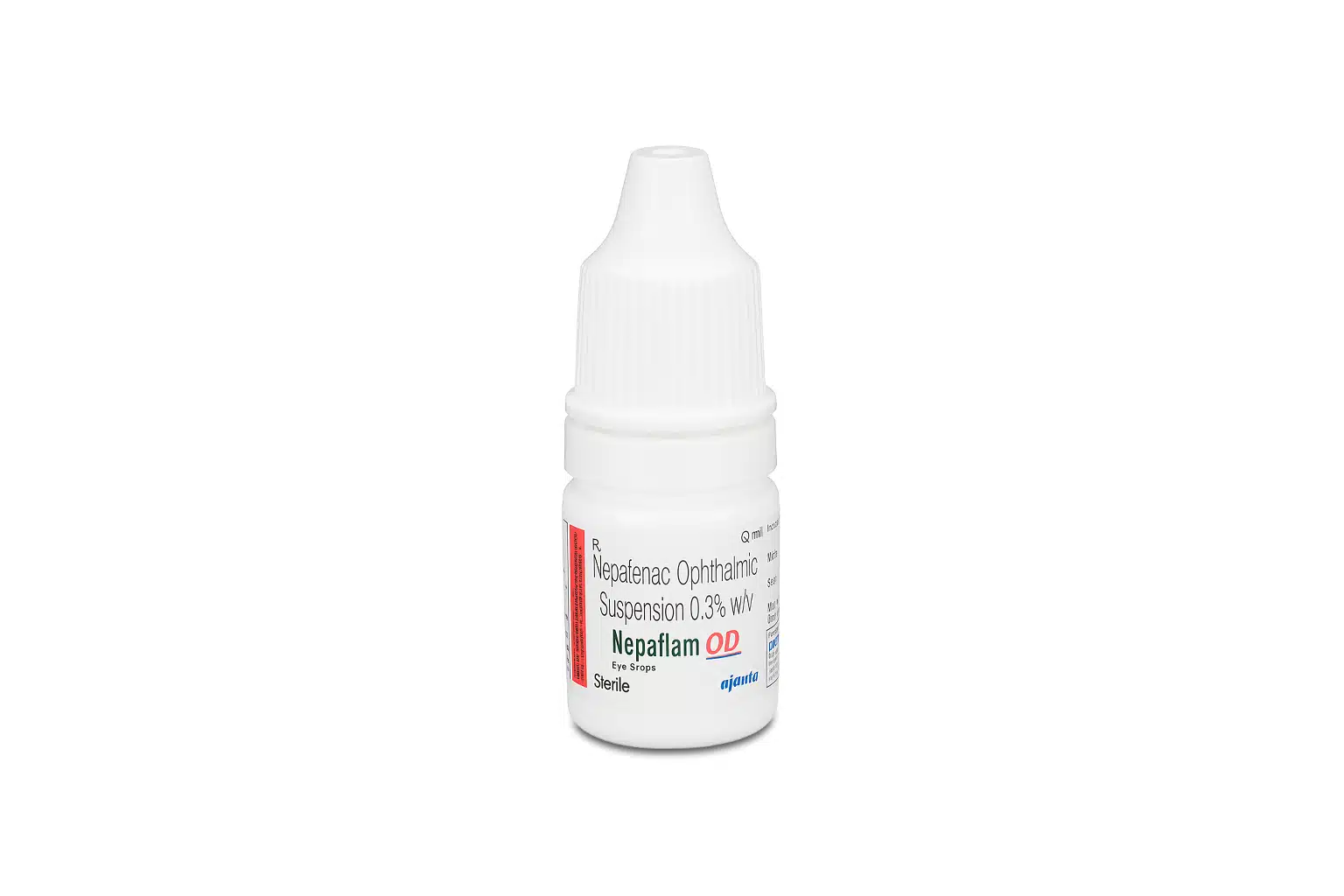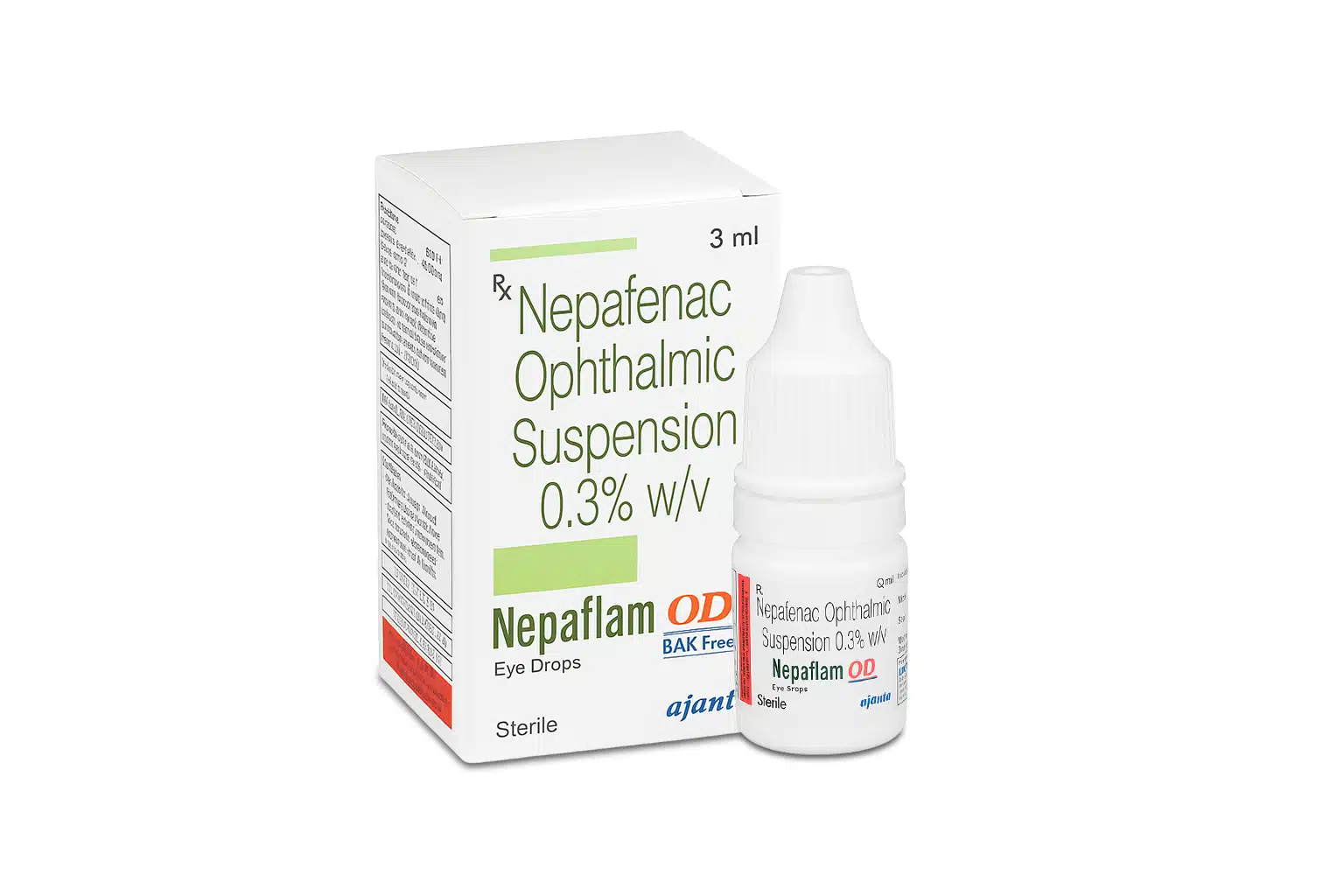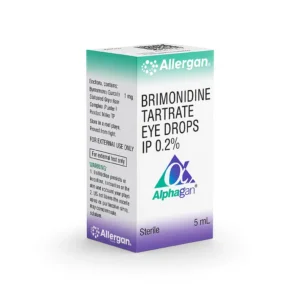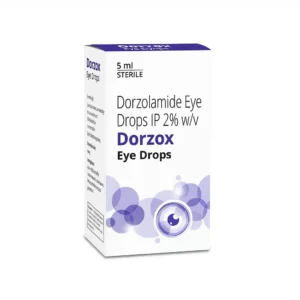Nepaflam OD 3 ml is an ophthalmic anti-inflammatory eye drop formulated with nepafenac, a proven non-steroidal anti-inflammatory drug (NSAID) used to relieve pain, redness, and swelling in the eyes. It is commonly prescribed after cataract surgery or other eye procedures to reduce discomfort and support faster healing.
| About Nepaflam OD 3 ml |
|---|
| Drug Class: Nonsteroidal anti-inflammatory drug (NSAID) |
| Subclass: Nepafenac |
| Product Details | |
|---|---|
| Composition | Active Ingredients • Nepafenac Inactive Ingredients • Boric acid • Castor oil |
| Packaging Type | Dropper bottle |
| Pack Size | 3 ml |
| Dosage | Apply 1 drop in the affected eyes |
| Therapeutic Class | Anti-inflammatory, analgesic |
| Action Class | COX-1 and COX-2 inhibitor |
| Chemical Class | NSAID |
| Manufacturer | Sun Pharmaceutical (Nepaflam) |
| Shelf Life | 2–3 years from the date of manufacturing |
| Usages | Treats post-operative inflammation, pain after cataract surgery |
| Country of Origin | India |
| Storage | Store at room temperature below 30°C; keep away from heat, light, and moisture |
How does Nepaflam OD 3 ml work?
- Nepafenac is a topical NSAID. Applied to the eye, it gets into the cornea and converts to the active molecule amfenac.
- This active form blocks enzymes called cyclooxygenases (COX-1 and COX-2). Blocking COX lowers prostaglandin production.
- Fewer prostaglandins mean less pain, less redness, and less swelling after surgery.
Uses
- To treat pain after cataract surgery.
- To reduce eye inflammation after cataract surgery.
- To lower the risk of postoperative macular oedema in patients at higher risk (for example, diabetic patients). NHS and regional formularies note this use.
Dosage
A 0.3% once-daily nepafenac formulation gives a steady anti-inflammatory effect with a single drop each day.
How to use Nepaflam OD 3 ml step by step
- Wash your hands.
- Tilt your head back and pull the lower lid down.
- Hold the bottle just above the eye and squeeze a single drop into the lower lid.
- Close your eyes gently for ~30 seconds. Blink slowly.
- Wipe away excess fluid with a clean tissue.
- Close and tighten the bottle cap.
- If you use other eye drops, leave at least 5–10 minutes between different drops so each can work.
Do not touch the bottle tip to your eye or eyelid. That helps keep the drops sterile.
Side effects
- Stinging
- Burning
- Temporary blurred vision
- Mild eye irritation
Interactions
- Blood Thinners (Anticoagulants/Antiplatelets): Concomitant use with medicines like warfarin, aspirin, rivaroxaban, or clopidogrel may increase the risk of bleeding in the eye tissues.
- Non-Steroidal Anti-Inflammatory Drugs (NSAIDs): Using Nepaflam OD with other systemic or topical (eye) NSAIDs (e.g., ibuprofen, diclofenac, naproxen) is not recommended as it increases the potential for adverse effects and may delay healing.
- Topical Steroids: Using Nepaflam OD concurrently with topical corticosteroid eye drops (e.g., hydrocortisone, dexamethasone, prednisone) should be done with caution, as both medications can slow or delay the healing process of the eye.
- Certain Glaucoma Medications: Use with certain another eye drops, such as latanoprost and travoprost, is generally not recommended.
- Alcohol and Tobacco: While interactions with the eye drops specifically are not fully established, systemic NSAIDs can interact with alcohol and tobacco to increase the risk of stomach bleeding. It is best to consult a doctor regarding alcohol consumption and smoking while using this medication.
Pharmacokinetics
- Nepafenac acts mainly on the eye surface and nearby tissues. Its active form works where inflammation is present.
- Nepafenac converts in ocular tissues to amfenac, the active NSAID. This lets the drug act where needed.
- Systemic absorption is very little of the drug reaches the bloodstream after eye use. The effect is mostly local.
Precautions in special groups
- Pregnancy and breastfeeding: Use only on doctor advice. Topical use gives low systemic exposure, but follows clinician guidance.
- Children: Use under pediatric ophthalmologist advice.
- Contact lens wearers: Remove lenses if the packaging or clinician advises. Some products are not lens-safe.
Conclusion
Nepaflam OD 3 ml is a once-daily nepafenac eye drop made to ease pain and lower inflammation after cataract surgery. It also helps reduce the risk of macular swelling in select high-risk patients. It works locally, has clear dosing guidance, and is supported by clinical studies and regulatory labels. Always follow your surgeon’s or pharmacist’s directions. If your eye worsens or you have sudden vision changes, seek care immediately.
References
https://pmc.ncbi.nlm.nih.gov/articles/PMC2693998/
https://pmc.ncbi.nlm.nih.gov/articles/PMC5768593/








Reviews
There are no reviews yet.